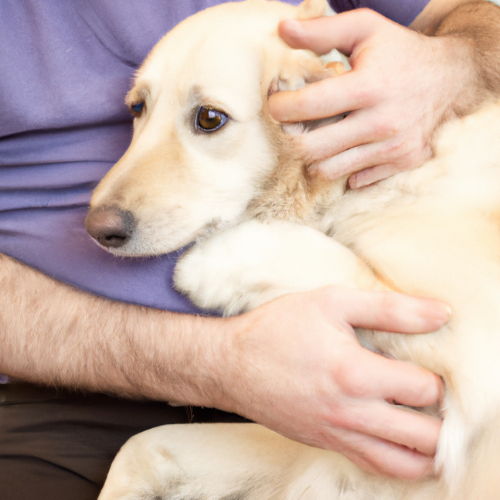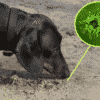If you’re a dog owner, the prospect of your furry friend giving birth to a litter of puppies can be both exciting and nerve-wracking. It’s essential to be able to identify the signs that your dog is in labor so that you can prepare for the arrival of the new pups.
One of the most common concerns for dog owners is figuring out whether their dog is peeing or if her water just broke. Unlike in humans, a dog’s water breaking is not always apparent. It usually happens during the second stage of labor when the dog is actively pushing or straining. If the dog is not in labor, it is more likely that she is urinating.

To help you figure out what’s going on with your pregnant dog, here are some tips that might be useful.
Identifying Amniotic Fluid
When a female dog is expecting puppies and preparing for delivery, her body secretes a special type of liquid known as amniotic fluid. This fluid is essential because it serves as a protective barrier for the developing puppies inside their mother’s womb.

Amniotic fluid is typically clear with a slight yellowish tinge and is odorless. The volume of amniotic fluid can vary depending on the number of puppies, but it is usually around one quart of fluid for each puppy. Sometimes it can be difficult to distinguish between amniotic fluid and urine; however, amniotic fluid is typically thinner and less yellow than urine, and it has a less pungent smell. If you are unsure whether your dog’s water has broken, it is advisable to seek guidance from a qualified veterinarian.
Pay Attention to Behavior
When a dog is nearing labor, there are several physical and behavioral changes that may occur. One of the most common indications that labor is imminent is restlessness. Your dog may appear fidgety, pant excessively, pace back and forth, or frequently get up and sit down. Additionally, your dog may seek extra attention from you and try to stay close.
Another sign of impending labor is nesting behavior. This means that your dog will start searching for a quiet, comfortable spot to give birth and may start shredding blankets or other materials to create a suitable nest. In the days leading up to labor, other physical changes may occur, such as a decrease in appetite, a drop in body temperature, and the loss of the mucus plug. It’s worth noting that not all dogs will display these signs, and some may go into labor without any warning. If you suspect that your dog is in labor or experiencing complications, it’s best to seek the advice of a qualified veterinarian.
If your dog is not displaying any changes in behavior, the chances are high that the fluid you found is urine rather than amniotic fluid.
Consult With Your Vet
If you are worried and unsure about your dog and concerned or confused about if her water has broken it’s always best to call your vet. They will be able to check your dog’s symptoms and understand if your dog has gone into labor or not. Alternatively, you can speak to a vet online if going to a vet in person is not convenient.
Prepare for Labor
Preparing your dog for labor is an essential part of responsible pet ownership. Ensuring your dog is comfortable and well-prepared for the birthing process is crucial for a safe delivery and healthy puppies. Here are some tips to prepare your dog for labor:
Recognize signs of labor: Before your dog goes into labor, it’s important to know the signs so that you can recognize when the time is near. Signs include restlessness, panting, nesting behavior, loss of appetite, and a drop in body temperature.

Create a cozy environment: Create a comfortable, quiet space for your dog to give birth. Choose a warm, clean, and peaceful area where your dog can feel safe and at ease. You can use blankets, towels, or a whelping box to create a snug and secure area for your dog. Gather necessary supplies: Prior to labor, ensure that you have all the necessary supplies ready, such as clean towels, heating pads, a thermometer, scissors, umbilical cord clamps, and sterile gloves. Have your veterinarian’s contact information on hand in case of emergency.
Monitor your dog’s health: In the weeks leading up to labor, it’s crucial to closely monitor your dog’s health. Watch for any signs of discomfort or illness, and consult with your vet if you have any concerns. Keep your dog up-to-date on all vaccinations and deworming. Be prepared for unforeseen circumstances: Despite careful planning, emergencies can still arise during labor. Develop a plan for dealing with complications and have the contact information for an emergency veterinary clinic readily available.
Offer support during labor: During labor, your dog may feel scared and in pain. Providing support and reassurance can help ease the process for your dog. Stay with your dog throughout labor and offer comfort and encouragement as needed.
How Do You Know if Your Dog’s Water Broke?
When a female dog’s water breaks, there will be a visible release of fluid. The liquid will be transparent and may have a mild sugary scent to it. Certain dogs may also exhibit licking or signs of distress or agitation around the vaginal region. If any of these symptoms are observed, it is probable that the dog’s water has ruptured, and she will likely give birth shortly.
Do Dogs Pee a Lot Before They Go Into Labor?
Dogs often need to urinate more frequently as they approach labor due to the pressure of the growing puppies on their bladder. However, this symptom alone may not necessarily mean that labor is about to begin. It is important to also watch for other signs of labor, such as nesting behavior, panting, and loss of appetite, to determine if your dog is ready to give birth.
How Long After Water Breaks Will Puppies Be Born?
After a dog’s water breaks, the birth of puppies usually occurs within 12 to 24 hours. However, this timeline can differ based on the specific dog and the number of puppies she is carrying. It is crucial to keep a close eye on your dog after her water breaks and be prepared for any potential emergencies. If more than 24 hours have passed since your dog’s water broke and she has not yet gone into labor, it is important to contact your veterinarian right away.
- How Long Should I Stay Mad at My Dog? [Guide]
- Why Is My Dog Digging at My Stomach? [Guide]
- Are Sycamore Seeds Poisonous to Dogs? [Acer Pseudoplatanus]
Conclusion
To sum up, it can be challenging to tell apart urine leakage and amniotic fluid in a pregnant dog. Nonetheless, there are some significant distinctions that can aid in identifying the cause. Urine leakage might result in small amounts of dribbled urine during walking or resting, whereas a dog’s water breaking will create a distinct rush of clear fluid, which could be accompanied by discomfort or restlessness. It is of utmost importance to keep a close eye on the pregnant dog and get in touch with a veterinarian right away if there are any worries about her health or the well-being of her puppies.

Doctor of Veterinary Medicine (D.V.M.) at Nation Taiwan University,Master of Science (M.S.) in Biomedical Engineering at National Taiwan University of Science and Technology




